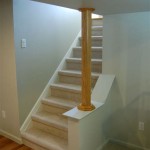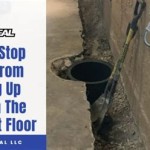Painting Concrete Block Walls in a Basement: A Comprehensive Guide
Painting concrete block walls in a basement is a common undertaking for homeowners aiming to improve the aesthetics, durability, and overall functionality of their below-ground spaces. Concrete block, also known as cinder block or CMU (Concrete Masonry Unit), is a porous material that can be susceptible to moisture intrusion and efflorescence. Properly preparing and painting these walls can mitigate these issues, creating a brighter, more welcoming, and more usable basement environment.
However, effectively painting concrete block walls requires more than simply applying a coat of paint. It's a multi-stage process that necessitates careful surface preparation, selection of appropriate materials, and meticulous application techniques. Neglecting any of these steps can result in paint failure, moisture problems, and the need for costly repairs.
Key Point 1: Preparation is Paramount
The success of any painting project, particularly one involving porous concrete block, hinges largely on the quality of the surface preparation. The goal of preparation is to create a clean, sound, and slightly porous surface that will allow the paint to properly adhere and perform as intended. This process involves several critical steps.
Cleaning: The first step is to thoroughly clean the concrete block walls. Over time, concrete block can accumulate dirt, dust, mold, mildew, and efflorescence (a white, powdery salt deposit). A stiff-bristled brush and a solution of water and TSP (trisodium phosphate) or a commercially available concrete cleaner can be used to scrub the walls. TSP is a strong cleaner and requires careful handling - always wear gloves and eye protection and follow the manufacturer’s instructions. Rinse the walls thoroughly with clean water and allow them to dry completely.
Efflorescence Removal: Efflorescence is a sign of moisture migrating through the concrete and depositing salts on the surface. While cleaning may remove the visible deposits, it's crucial to address the underlying moisture problem. A wire brush can be used to aggressively remove stubborn efflorescence. In severe cases, a muriatic acid solution (diluted according to the manufacturer's instructions and handled with extreme caution, including proper ventilation, protective gear, and eye protection) might be required. After using muriatic acid, the walls must be neutralized with a baking soda solution and rinsed thoroughly.
Repairing Cracks and Holes: Any cracks or holes in the concrete block walls must be repaired before painting. Small cracks can be filled with a concrete patching compound or hydraulic cement. Larger cracks and holes may require the use of a concrete repair mortar. Follow the manufacturer's instructions for mixing and applying the patching material. Allow the repair material to cure completely before proceeding with painting. Hydraulic cement is often preferred for areas with known moisture issues due to its ability to set quickly even in damp conditions.
Addressing Moisture Issues: Before painting, it is crucial to identify and address the source of any moisture problems. Painting over damp concrete block is a recipe for disaster, as the paint will eventually blister, peel, and fail. Common sources of moisture include poor drainage around the foundation, leaking gutters, cracks in the foundation, and condensation. Addressing these issues may involve improving drainage, repairing cracks, installing a dehumidifier, or improving ventilation.
Etching (Optional but Recommended): Etching the concrete block creates a slightly rough surface, which improves paint adhesion. This can be accomplished using a commercially available concrete etching solution or a diluted muriatic acid solution (again, with extreme caution). After etching, the walls must be thoroughly rinsed with clean water and allowed to dry completely.
Key Point 2: Selecting the Right Paint and Primer
Choosing the correct paint and primer is crucial for achieving a durable and long-lasting finish on concrete block walls in a basement environment. Not all paints are created equal, and some are specifically formulated to withstand the unique challenges of concrete and basement conditions.
Primer: A primer is essential for sealing the porous surface of the concrete block and providing a uniform base for the paint. A high-quality alkali-resistant primer is recommended, as concrete is alkaline and can react with certain types of paint. Look for primers specifically designed for concrete or masonry surfaces. Epoxy-based primers offer excellent moisture resistance and adhesion, making them a good choice for basements. Apply the primer according to the manufacturer's instructions, typically using a brush, roller, or airless sprayer. Allow the primer to dry completely before applying the paint.
Paint: The best type of paint for concrete block walls in a basement is typically a high-quality acrylic latex paint with a mildew-resistant additive. Acrylic latex paints are breathable, allowing moisture vapor to escape from the concrete block, which helps prevent blistering and peeling. They are also durable, scrubbable, and easy to clean. Epoxy paints provide excellent durability and moisture resistance but can be more difficult to apply and may require special surface preparation. Avoid using oil-based paints, as they are not breathable and can trap moisture, leading to paint failure. Choose a paint with a satin or semi-gloss finish, as these finishes are more resistant to moisture and easier to clean than flat finishes.
Moisture-Resistant Coatings: In basements with persistent moisture problems, consider using a waterproof or moisture-resistant coating specifically designed for concrete block walls. These coatings are typically thicker and more durable than standard paints and can provide an extra layer of protection against water intrusion. However, it is still essential to address the underlying moisture issues before applying these coatings.
Testing for Lead Paint (Important Safety Precaution): If the basement walls have been painted previously, especially in older homes, it is crucial to test for lead paint before sanding or scraping. Lead paint can be hazardous to your health, and proper precautions must be taken if it is present. Lead test kits are readily available at most hardware stores. If lead paint is detected, consult with a professional lead abatement contractor.
Key Point 3: Application Techniques and Considerations
Proper application techniques are essential for achieving a smooth, even, and durable finish on concrete block walls. Paying attention to detail and using the right tools can make a significant difference in the final result.
Tools: The tools needed for painting concrete block walls include: paintbrushes (both angled and flat), paint rollers with extension handles, paint trays, drop cloths, painter's tape, a ladder (if necessary), and safety glasses. A paint sprayer can be used for faster and more even coverage, but it requires more skill and preparation.
Application: Start by applying painter's tape to protect trim, windows, doors, and other surfaces that you don't want to paint. Use a brush to paint the edges and corners of the walls, a process known as "cutting in." Then, use a roller to paint the main surfaces. Work in small sections, overlapping each stroke to ensure even coverage. Apply two coats of paint, allowing each coat to dry completely before applying the next. Follow the manufacturer's instructions for drying times.
Filling the Pores: Concrete block is porous, and it may require multiple coats of primer and paint to completely fill the pores. Pay close attention to the surface after each coat and apply additional coats as needed to achieve a smooth, even finish. Using a roller with a thick nap can help to fill the pores more effectively.
Ventilation: Ensure adequate ventilation while painting, especially when using paints with strong odors. Open windows and doors, and use a fan to circulate air. Wear a respirator if necessary.
Curing Time: Allow the paint to cure completely before using the basement. Curing time can vary depending on the type of paint and the environmental conditions. Refer to the manufacturer's instructions for recommended curing times.
Ongoing Maintenance: Periodically inspect the painted concrete block walls for signs of moisture damage, cracking, or peeling. Address any problems promptly to prevent further damage. Clean the walls regularly with a mild detergent and water to remove dirt and grime. By following these guidelines, it is possible to transform a basement with concrete block walls into a brighter, more attractive, and more usable space.

Painting Cinder Block Walls In A Basement Or Re Paint Them

Concrete Block Walls Cinder Basement Remodeling

Basement Finishing Do Not Paint Your Walls

Painting Cinder Block Walls In A Basement Or Re Paint Them

Painting Cinder Block Walls In A Basement Or Re Paint Them

Painting Cinder Block Walls In A Basement Or Re Paint Them

Basements And Foundations Tips

Diy Projects And Ideas Cinder Block Walls Concrete Basement Makeover

6 Best Paints For Concrete Basement Walls
Best Basement Wall Paint On 100 Year Old Cinderblocks Diy Home Improvement Forum
Related Posts







